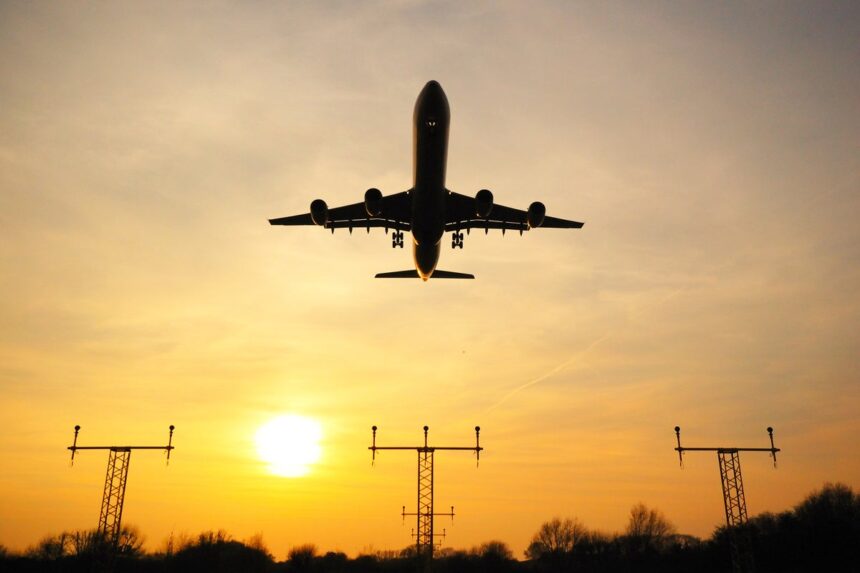On January 29 a U.S. Army Black Hawk helicopter collided midair with an American Airlines passenger jet near Ronald Reagan Washington National Airport, killing 67 people. Although air traffic controllers in the airport tower at the time saw warning signals flash across their screens at least 20 seconds beforehand and attempted to notify both aircraft, they weren’t able to prevent the accident. Crash investigations are ongoing, but aviation experts agree that some degree of human error played a role—maybe in the cockpits, maybe in the tower. Could this crash, and several other high-profile airplane accidents since then, have been avoided if artificial intelligence were running air traffic control (ATC) alongside human controllers? Researchers are testing systems right now to see how they might perform.
Near misses and accidents have received particular scrutiny this year, as increasingly short-staffed and overworked ATC workers try to monitor thousands of flights each day. Their work relies on many systems that have remained virtually unchanged for decades: runway lights are supported by technology first rolled out in the 1980s, and controllers in some towers still use paper to track aircraft movements. But perhaps the most analog aspect of ATC is that human beings are needed to guide pilots at every stage of flight.
As global air traffic increases and staffing shortages persist, the aviation industry is exploring whether artificial intelligence should play a larger role in ATC. Proponents argue that AI could reduce human error and improve efficiency, while skeptics point to its limitations in handling unpredictable scenarios. With trials underway at major airports, the question is not just whether AI will be integrated but how much responsibility it should assume.
On supporting science journalism
If you’re enjoying this article, consider supporting our award-winning journalism by subscribing. By purchasing a subscription you are helping to ensure the future of impactful stories about the discoveries and ideas shaping our world today.
Given the meteoric rise of AI applications, the control tower may be ripe for full automation in the near future. Human intervention would be the exception, not the rule. Today controllers use a combination of radar and flight location data automatically transmitted by aircraft to track plane position, altitude and speed. They monitor data on digital displays, but they also scan runways with their eyes; since its inception in the 1920s, ATC has always involved such line-of-sight observations.
Many key aspects of ATC have already been automated. Controllers and pilots make flight planning decisions based on live reports of weather, turbulence and air traffic from other pilots and control centers, not guesswork. Collision avoidance and altitude systems on planes prevent two aircraft from crashing midflight. Remote sensors that measure runway visibility and digital weather data are widely used in addition to advanced radar systems. Industry leaders say that although it’s hard to quantify the utility of these systems, they have arguably reduced collisions. Yet as recent news has shown, accidents still happen.
Most airline accidents occur while planes are taxiing, taking off or landing. Controllers have to constantly plan ahead: they must balance flights in airspaces that can range from just a few cubic miles at the busiest airports, where planes must be lined up only minutes apart, to midflight (high-altitude) sectors spanning more than 30,000 cubic miles. Intense workload increases the risk a controller will fail to anticipate events. AI could help controllers detect potential airspace conflicts earlier and alert them to subtle anomalies they might miss, especially when controllers are fatigued.
For instance, the U.K.’s air navigation service provider NATS is testing an advanced AI-based system at London’s Heathrow Airport. Called Artificial Intelligence for Managing Integrated Environmental Elements, or Aimee, the tech is meant to assist air traffic controllers at busy international hubs. Human controllers alternate their gaze to monitor different planes in different positions, but aviation technology company Searidge Technologies, which is owned by NATS, equipped Aimee with 360-degree panoramic vision. This way, the AI can monitor multiple aircraft positions continuously, flagging what it sees as a potential conflict and nudging a controller to focus on that issue. Either the controller or, someday, Aimee itself would make any decisions to alter a plane’s position or course.
“Once we digitize what controllers monitor, we can hand that data to an AI engine,” says Andy Taylor, chief solutions officer at NATS and a former air traffic controller. Aimee analyzes multiple data sources—including live video feeds that capture arriving and departing flights, the ground environment around aircraft, and transcribed voice commands from pilots—to enhance monitoring of aircraft as they taxi, take off and land.
“The system can be trained to look for exactly the same things that a controller is looking for,” Taylor says, such as checking that a plane’s tail has cleared a runway or scanning a 2.5-mile-long stretch of tarmac in real time. This digital tower, working from within existing analog towers, could have much more high-fidelity views of the entire ATC operation, relying in part on arrays of fixed cameras that provide immediate views of the entire airfield. Human controllers working these digital towers would no longer have to continuously scan airplanes in all directions, and they could also track objects great distances away or those obscured by cloud cover. AI could provide an audible warning to controllers about troubling plane movements on the taxiway, and it could give pilots a warning, too.
Digital towers could someday also be used to enhance an aging tower to handle increased traffic without rebuilding the facility, and they could reduce maintenance costs. In tests at Heathrow and at Singapore Changi Airport, Aimee has helped manage ground traffic and aircraft clearance, signaling a path forward for a possible hybrid human-machine collaboration. In London, the U.K.’s Civil Aviation Authority could perhaps give the AI system control over more functions once it’s been proved safe, potentially improving the timeliness, efficiency, accuracy and safety of ATC.
AI might also improve the Traffic Alert and Collision and Avoidance System (TCAS), a warning system used on aircraft throughout the world that tells pilots when to climb or descend. “TCAS is extremely successful but also very rigid,” says James Kuchar, an assistant head of the Homeland Protection and Air Traffic Control Division at the Massachusetts Institute of Technology’s Lincoln Laboratory. “The system is safe but tends to give false alarms” to pilots and ATC workers when planes fly close together, Kuchar says, “which they do more often now than when it was designed in the 1980s.” Airborne Collision Avoidance System X (ACAS X), the upgraded system being tested at Lincoln, is informed by AI and has been run through millions of simulated near misses. One goal of ACAS X is in fact to reduce false alarms. It can also warn planes to move laterally in the sky; TCAS can only direct planes to descend or climb.
AI control would raise legal and ethical questions. Could AI be blamed for an accident? How risk-averse would an automated ATC system be? How risk-averse should it be? Some of the aviation experts I spoke with think policymakers have a duty to the flying public to establish a legal framework surrounding this emergent technology.
Assisted ATC also reveals the limits of AI and the risks that come with full automation. Aviation experts aren’t confident that the benefits would outweigh possible new problems resulting from increased automation in the tower. For one thing, AI currently lacks the creativity, intuition or adaptability needed to deftly handle any emergency that deviates from historical flight data. Automated technology adds another layer of unpredictability to a system already mired in uncertainty. Forcing pilots and controllers to become more dependent on technology could erode their ability to make quick decisions. And increased digitization of ATC systems could make them vulnerable to cybersecurity threats.
“Automation is heralded as the solution, but it can actually make things worse,” says John Leahy, a former chief pilot at British Airways and a member of the Royal Aeronautical Society, an international membership organization of air safety experts. “The suggestion that computers can perform ATC tasks better than humans is a dangerous path.”
Indeed, what happens if a human controller becomes over-reliant on a machine? “If you start depending on automation, you lower your guard,” says Shem Malmquist, an instructor at the Florida Institute of Technology’s College of Aeronautics and a Boeing 777 pilot. Malmquist is not against automation. He cites the controller-pilot data link communications system, which consists of text and audio technology that relays info from the ground to aircraft, as an example of a navigation tool that deftly combines human and machine intelligence. “This system is very useful for something routine because it lowers a controller’s workload,” Malmquist says.
Although AI has the potential to speed up operations, relieve short-staffed control towers and lead to safer skies, Malmquist says creative decisions can’t be made with algorithms alone. For now, humans are still making the calls.







